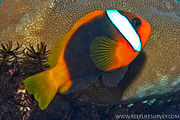Amphiprion mccullochi
| Amphiprion mccullochi | |
|---|---|

| |
| Scientific classification | |
| Kingdom: | |
| Phylum: | |
| Superclass: | |
| Class: | |
| Order: | |
| Family: | |
| Genus: | |
| Species: | A. mccullochi
|
| Binomial name | |
| Amphiprion mccullochi Whitely 1929
| |

Amphiprion mccullochi (whitesnout anemonefish or McCulloch's clownfish) is a marine fish belonging to the family Pomacentridae, the clownfishes and damselfishes, found only at Lord Howe Island and Norfolk Island.[1]. It was named for Allan McCulloch, a former Curator of Fishes at the Australian Museum, Sydney.[2]
Characteristics of Anemonefish
Clownfish or anemonefish are fishes that, in the wild, form symbiotic mutualisms with sea anemones and are unaffected by the stinging tentacles of the host anemone, see Amphiprioninae § Symbiosis and mutualism. The sea anemone protects the clownfish from predators, as well as providing food through the scraps left from the anemone's meals and occasional dead anemone tentacles. In return, the clownfish defends the anemone from its predators, and parasites.[3] Clownfish are small-sized, 10–18 centimetres (3.9–7.1 in), and depending on species, they are overall yellow, orange, or a reddish or blackish color, and many show white bars or patches. Within species there may be color variations, most commonly according to distribution, but also based on sex, age and host anemone. Clownfish are found in warmer waters of the Indian and Pacific oceans and the Red Sea in sheltered reefs or in shallow lagoons.
In a group of clownfish, there is a strict dominance hierarchy. The largest and most aggressive fish is female and is found at the top. Only two clownfish, a male and a female, in a group reproduce through external fertilization. Clownfish are sequential hermaphrodites, meaning that they develop into males first, and when they mature, they become females.
Description
A. mccullochi is dark brown with a pale snout, a white bar on each side of the head (but not connected on top of the head) and a pale tail. Juveniles have two white bars and the edge of the pectoral fins is yellow. They have 10 dorsal spines, 2 anal spines, 15-17 dorsal soft rays and 13-14 anal soft rays.[4] They reach a maximum length of 12 cm (4+3⁄4 in).[1]
Color variations
None known.
Similar species
A. mccullochi is similar in appearance to A. melanopus which is distinguished by its reddish chest, belly and dorsal fin, with a yellowish to slightly red tail. The white bars are also connected over the top of the head.[1] Genetic analysis suggested evolutionary connectivity among samples of A. mccullochi and A. akindynos. Historical hybridization and introgression in the evolutionary past resulted in a complex mitochondrial DNA structure. There were two evolutionary groups with individuals of both species detected in both, thus the species lacked reciprocal monophyly. There were no shared haplotypes between species.[5]
-
A. mccullochi (Whitesnout anemonefish)
-
A. melanopus (Red & Black anemonefish)
-
A. akindynos (Barrier Reef anemonefish)
Distribution and Habitat
A. mccullochi is only found in the south western Pacific ocean at Lord Howe Island, Middleton Reef, Elizabeth Reef and Norfolk Island.[1] The small geographic range, small local population and extreme habitat specialisation (it only associates with Entacmaea quadricolor) are all characteristics known to elevate the risk of extinction making A. mccullochi of particular conservation concern.[5]
Host anemnones
A. mccullochi is associated with the following species of anemone:
- Entacmaea quadricolor Bubble-tip anemone[1]
In aquaria
This species has bred in captivity.[6][7]
References
- ^ a b c d e Fautin, Daphne G.; Allen, Gerald R. (1997). Field Guide to Anemone Fishes and Their Host Sea Anemones. Western Australian Museum. ISBN 9780730983651. Archived from the original on 14 April 2015.
{{cite book}}: Cite has empty unknown parameter:|1=(help) - ^ Bray, Dianne. "McCulloch's Anemonefish, Amphiprion mccullochi". Fishes of Australia. Retrieved 2 September 2015.
- ^ "Clown Anemonefish". Nat Geo Wild : Animals. National Geographic Society. Retrieved 2011-12-19.
- ^ Froese, Rainer; Pauly, Daniel (eds.). "Amphiprion mccullochi". FishBase. November 2014 version.
- ^ a b van der Meer M.H.; G.P. Jones; J-P.A. Hobbs; L. van Herwerden (2012). "Historic hybridization and introgression between two iconic Australian anemonefish and contemporary patterns of population connectivity". Ecology and Evolution. 2 (7): 1592–1604. doi:10.1002/ece3.251.
- ^ "Captive breeding of the rare McCulloch's Clownfish (Amphiprion mccullochi) Updates & Blog". Retrieved 2014-08-31.
- ^ "McCullochi Clownfish". Retrieved 2014-08-31.
External Links
- "Amphiprion mccullochi". Integrated Taxonomic Information System.
- Amphiprion mccullochi. Whitely, 1929. Retrieved through: World Register of Marine Species.



